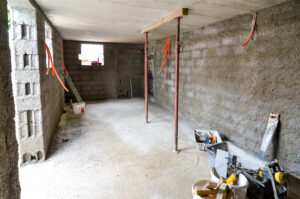If you are looking for how you can cure a musty or wet basement, you must be curious about the advertisements that claim to waterproof the basement walls. Here you wonder if it is possible to dry your basement just by sealing the borders.
Is it possible? Yes, it is, but you have to be sure that you are choosing the right option. Then you need to figure out whether the moisture is coming from the outside or just the incident of high humidity, considering the cool walls for the basement.
How to know the reason behind the moisture?
To know about the moisture in your basement, you need to tape a foot piece of the square of aluminium foil, place it inside the basement walls, and leave it untouched for about 24 hours. If you find condensation outside the foil, then your basement has high humidity. Try to fix it with the help of a room dehumidifier; they are available in portable form to transfer from one place to another easily. Waterproofing the interior walls will solve the issue; else, you can try waterproofing the exterior walls; it’s a better solution than just a bit expensive.
Some of the best practices for waterproofing your basement:
Determine the water source:
As the concrete is porous, you ought to see wet streaks to let you know where the water is peeping. Do look for spots with the cracks at the window corners between the mortar joint and also around the pipe’s entry and exit. Also, try performing a simple condensation test to know about the water source and help yourself with the moisture source.
Water Damage Signs:
If you tend to discover leaks or moisture in your foundation, then don’t panic. You can choose porous material as it is susceptible to cracking from the hydrostatic pressure underground. If you are never sure about the remediation, you can contact a professional waterproofing company just like Bayset to help you with the basement inspection. They do have the skills and expertise required for performing waterproofing.
Try applying the masonry waterproofing product to the basement walls:
Once you know water is penetrating through the basement walls, then leaving them wet and sealing the interiors with high-quality waterproof paints can be one of the solutions. This type of sealant arrives premixed and also works like a paint coat on walls. While waterproofing your basement walls, you need to roll or brush the paint thickly enough to fill the holes and then ensure that they dry completely before applying the second coat. On drying, the sealant forms a watertight bond to prevent any more moisture from peeping through.
Address to window leaks:
The window well is a common phenomenon for basement wall leaks as they tend to retain water, especially when a proper drainage system is not installed while building the house. It can also lead to water pooling just around the basement window and then start sleeping in. It’s difficult to establish a perfect window well drainage system after considering digging for about 2 feet under the good area and then filling it with the gravel and other solutions to fix it.
Do take proper steps to make your basement waterproof:
At times you will find the solution for wet walls is quite easy. For example, removing foundation plantings like flower beds and bushes requires continuous water, which can seep into the basement. You can also inspect if required repair downspouts and gutters to ensure they are directed away from your basement.
Interior drainage solutions:
One of the other methods for drying your basement walls is by installing a drainage channel. The installation is done beneath the floor and inside the basement. Then new walls can be built up inside the drain to ensure that originals are not visible. Once you do it, you will have new walls, and if any residual water penetrates via old basement walls, it will be directed through the channel and pumped away.
Never apply a sealer to the painted walls:
If you have owned the place for years and have painted the basement walls, then to apply sealer, you need to remove the paint. It is common to find many coats of colour in the older homes and can be released with the sandblasters, or wire brushing is also a great alternative.
Read more:
7 Best Practices For Basement Waterproofing















